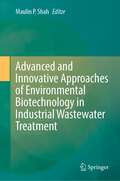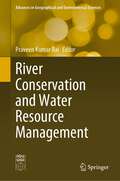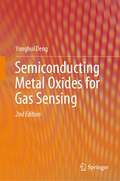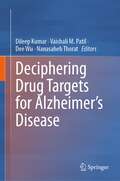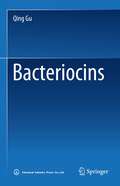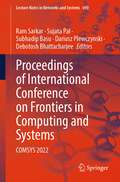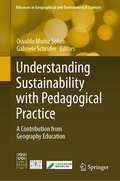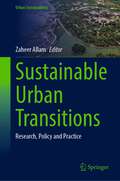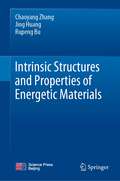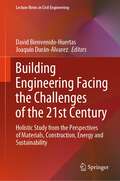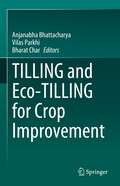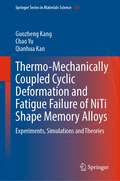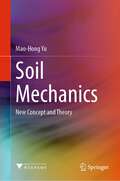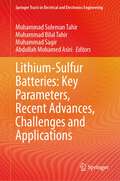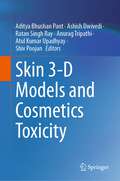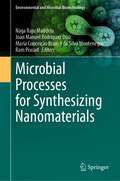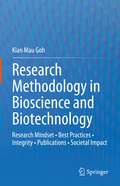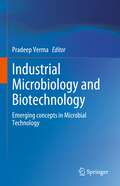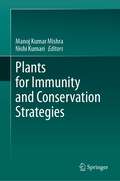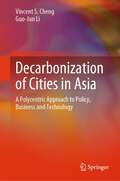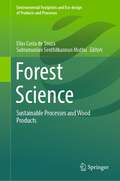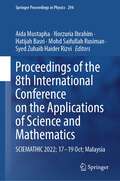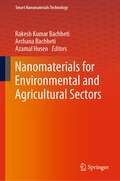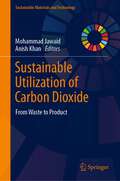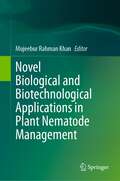- Table View
- List View
Advanced and Innovative Approaches of Environmental Biotechnology in Industrial Wastewater Treatment
by Maulin P. ShahThis book discusses new and innovative trends and techniques in the removal of toxic and refractory pollutants by means of various microbial biotechnology processes from wastewater, both on the laboratory and industrial scales. The book also highlights the main factors contributing to the removal of toxic pollutants as well as recycling, environmental impact, and wastewater policies after heavy metal removal. In addition, it assesses the potential application of several existing bioremediation techniques and introduces new cutting-edge emerging technologies. This book significantly contributes to the wastewater treatment plant industry so that the treatment systems can serve better and more resiliently for the purpose. This book is designed for engineers, scientists, and other professionals who are seeking introductory knowledge of the principles of environmental bioremediation technology and for students who are interested in the environmental microbiology and bioremediation fields.
River Conservation and Water Resource Management (Advances in Geographical and Environmental Sciences)
by Praveen Kumar RaiThis book presents an up-to-date, systematic and scientific analysis of water resource problems in India and suggests measures to overcome them through effective water management. In addition, the book provides an overview of how changes in legislation, policies, institutional responsibilities, science, technology, practical techniques and public perception have influenced the ways of river management over the past years. River water conservation is a planned activity connected with various habitat features and outlines how to conserve all river water spread across the world. The restoration and conservation of river water must be of the highest priority for sustaining humanity and ecology for the present and future generations. In order to solve the water problems, conservation and recycling of water should be made mandatory for all domestic, industrial and agricultural projects. Apart from the priority to watershed development, rainwater harvesting and other appropriate conservation measures should be adopted to create awareness among the public so that their mind-set, attitudes and habits change proactively and they adopt sustainable practices rather than wait for legislation and regulations. The book augments the knowledge base of behaviour of rivers and evaluates the issues related to rivers so as to develop river system management techniques emerging from in-depth scientific analyses. It is useful for students, researchers, water resource managers, hydrologists and all those who are engaged or interested in any aspect of river water conservation and management of water resources in the country.
Semiconducting Metal Oxides for Gas Sensing
by Yonghui DengThe second edition of this book focuses on the synthesis, design, and application of semiconducting metal oxides as gas sensing materials, including the gas sensing mechanism, and modification methods for sensing materials, while also providing a comprehensive introduction to semiconductor gas sensing devices. As an essential part of IoT (Internet of things), gas sensors have shown great significance and promising prospects. Therefore, studies on functional mesoporous metal oxides, one of the most important gas sensing materials based on their unique Knudsen diffusion behavior and tailored pore structure, have increasingly attracted attention from various disciplines. The book offers a valuable reference guide to metal oxide gas sensing materials for undergraduate and graduate students alike. It will also benefit all researchers who are involved in synthesis and gas sensing of metal oxides nanomaterials with relevant frontier theories and concepts. Engineers working on research and development of semiconductor gas sensors will also find some new ideas for sensor design.
Deciphering Drug Targets for Alzheimer’s Disease
by Dileep Kumar Vaishali M. Patil Dee Wu Nanasaheb ThoratThis book explains the fundamental characteristics and biofunctionality of Alzheimer’s Disease drug targets and provides up-to-date information on the full range of their biomedical applications. An introductory section gives an overview of the recent developments related to drug targets identified and studied related to Alzheimer’s Disease and key developments from preclinical and clinical studies focusing on various molecular targets related to AD and dementia by subject experts all around the globe. Here, individual chapters address the progress and perspectives in human and non-human research, role of various biomarkers as an overview, advanced gene therapy, and novel compounds for therapeutic targets for Alzheimer’s disease. The book will be essential reading for graduate students, scientists, and engineers in any of the biomedical research fields in which efforts are being made to utilize novel drug targets and develop effective strategies for new drug targeting and delivery in Alzheimer’s disease treatment.
Bacteriocins
by Qing GuThis book intends to report the new results of the study of bacteriocins, from basic research to application fields. It mainly introduces the biological characteristics of bacteriocins, the relationship between their structure and function, the antibacterial mode of action, and their application as antibacterial agents in food industry, medical care, and other areas, especially their application potential in human health. This book can be used as a reference book for researchers, undergraduates, and graduated students in the professional fields of food science and engineering, bioengineering, medicine, and agriculture.
Proceedings of International Conference on Frontiers in Computing and Systems: COMSYS 2022 (Lecture Notes in Networks and Systems #690)
by Ram Sarkar Sujata Pal Subhadip Basu Dariusz Plewczynski Debotosh BhattacharjeeThis book gathers high-quality research papers presented at the 3rd International Conference on Frontiers in Computing and Systems (COMSYS 2022) held at Indian Institute of Technology Ropar, Punjab, India, during December 19–21, 2022. The book covers research in “cyber-physical systems for real-life applications” pertaining to AI, machine learning, and data science; devices, circuits, and systems; computational biology, biomedical informatics and network medicine; communication networks, cloud computing and IoT; image, video and signal processing; and security and privacy.
Understanding Sustainability with Pedagogical Practice: A Contribution from Geography Education (Advances in Geographical and Environmental Sciences)
by Osvaldo Muñiz Solari Gabriele SchrüferThis book shares with an international audience of teachers, scholars, and policymakers the experience of pedagogical practices to facilitate sustainability in the world. Sustainability is seen here as a journey toward the end state of sustainable development. Therefore, the authors contribute different roads to engage teachers and students with pedagogical discourse. Overall, the book demonstrates the value of powerful knowledge through action-oriented learning based on a bottom-up process. Consequently, pedagogical practices are understood as the instructional approaches based on a social constructivist model in which active learning is performed with student-to-student engagement. Secondary teachers in social sciences and university professors in geography find the study to be a valuable source of stimulation for incorporating new ideas and resolving common problems in their learning and teaching environments. Education policymakers around the world also benefit from the only publication that presents international perspectives on geographical knowledge related to sustainability.The contributing authors are experienced scientists in the field of geography education who are giving special attention to pedagogical practices that promote new directions toward sustainable thinking.This book is the first outcome of an international collaboration officially established in 2023 between the Department of Geography and Environmental Studies at Texas State University and the Department of Geography at the University of Bayreuth.
Sustainable Urban Transitions: Research, Policy and Practice (Urban Sustainability)
by Zaheer AllamThis book aims to explore how sustainability transitions can be explored in current and future cities and how research and policy approaches can be applied to change urban life as we know it, hence aligning the two thematic of urban science and future science, for achieving deep decarbonization. On this, the discourse on philosophy, ethics, and morality appertaining to sustainable cities and urban transitions, across disciplines, are also welcomed as it provides a deeper understanding of humanity in future scenarios. Chapter 08 is available open access under a Creative Commons Attribution 4.0 International License via link.springer.com.
Intrinsic Structures and Properties of Energetic Materials
by Chaoyang Zhang Jing Huang Rupeng BuThis book highlights the intrinsic structures of all kinds of energetic compounds and some structure–property relationships therein. Energetic materials are a class of energy materials that can transiently release a large amount of gases and heat by self-redox after stimulated and usually refer to explosives, propellants and pyrotechnics. Nowadays, in combination with various theories and simulation-aided material design technologies, many new kinds of energetic materials like energetic extended solids, energetic ionic salts, energetic metal organic frames, energetic co-crystals and energetic perovskites have been created, in addition to traditional energetic molecular crystals. It is somewhat dazzling, and an issue of how we can understand these new types of energetic materials is raised. In the past about 20 years, we were immersed in the computational energetic materials. By means of defining a concept of intrinsic structures of energetic materials, which refers to the crystal packing structure of energetic materials, as well as molecule for molecular solid specially, the microscopic structures have been mostly clarified, and related with many macroscopic properties and performances, with molecular simulations. This book presents our understanding about it. Thereby, a simply and new way to readily understand energetic materials is expected to be paved, based on this book. It contains energetic molecular crystals, energetic ionic crystals, energetic atomic crystals, energetic metallic crystals and energetic mixed-type crystals and the substructures closest to crystal packing. Meanwhile, the common intermolecular interactions in energetic crystals will be introduced. In addition, theoretical and simulation methods for treating the intrinsic structures will be briefed, as they are the main tools to reveal the molecules and crystals. Besides, the polymorphism as a level of intrinsic structures will be briefly discussed. In the final of this book, we introduce the crystal engineering of energetic materials. This book features the first proposal of intrinsic structure and crystal engineering of energetic materials and the understanding of the properties and performances of energetic materials by maintaining a concept that structure determines property. It helps to promote the rationality in creating new energetic materials, rather than increase experience.
Building Engineering Facing the Challenges of the 21st Century: Holistic Study from the Perspectives of Materials, Construction, Energy and Sustainability (Lecture Notes in Civil Engineering #345)
by David Bienvenido-Huertas Joaquín Durán-ÁlvarezBuilding engineering is a complex and constantly evolving branch. The needs of the XXI century society cause a constant change in construction industry due to the need to achieve sustainable and ecological buildings. This affects all levels and phases of this engineering. Given this circumstance, numerous researchers turn their efforts to find optimal solutions for building engineering. For this reason, in this book a holistic analysis of building engineering is carried out from the perspectives that have a greater weight for sustainability objectives. The book is divided into 6 sections: (i) Building materials, which deals with research related to the most innovative and sustainable building materials; (ii) Design and construction, which deals with existing methodologies and advances in design and construction in construction sector; (iii) Building repair and maintenance, which deals with building repair, maintenance and upkeep techniques; (iv) Energy efficiency, which analyses the latest research on the energy efficiency of buildings and their behaviour in the face of climate change; (v) Sustainability, which analyses the establishment of measures to achieve a more sustainable built environment; and (vi) construction management, which compiles the latest studies in the field of Project manager. The 38 chapters of the book together constitute an advance for the topic of building engineering. The aspects covered in the book are of great interest to various sectors, such as researchers, engineers, architects, legislators and interested parties.
TILLING and Eco-TILLING for Crop Improvement
by Anjanabha Bhattacharya Vilas Parkhi Bharat CharThis edited book is a comprehensive compilation of deliberations in the field of agriculture, food security, climate resilient crops and on the relevance of the popular TILLING technique in the era of precise genome editing (CRISPR/Cas9). This book particularly deliberates on new developments in this field, such as, induced mutagenesis techniques, mutagenesis in somatic tissues, bio-informatics analysis and gene mining. This volume also focuses on next generation mutation detection techniques, exome capture, forward and reverses genetics, trait selection and, finally deliberates on the future of TILLING in plant breeding and product development. TILLING (Targeting Induced Local Lesions in Genome) is a popular molecular biology technique for detecting polymorphism in a mutagenized population. Eco-TILLING refers to natural TILLING. This technique can be applied to a wider range of crops. Products developed through TILLING are not regulated throughout the world, thus having a wider acceptance among various stakeholders. This volume is timely and looks into the updated aspects of mutagenesis, TILLING, Eco-TILLING along with OMIC tools, their amalgamated applications towards crop improvement. This book contains 11 chapters and 250 pages authored by globally reputed scientists on the field of mutagenesis, TILLING and Eco-TILLING. This book is useful for research scholars, students, teachers and scientists in the academia, policy makers, relevant public, plant breeding companies, private companies and cooperatives interested in understanding or applying mutagenesis, TILLING for editing gene of interest and develop new products in agriculture.
Thermo-Mechanically Coupled Cyclic Deformation and Fatigue Failure of NiTi Shape Memory Alloys: Experiments, Simulations and Theories (Springer Series in Materials Science #335)
by Guozheng Kang Chao Yu Qianhua KanWritten by leading experts in the field, this book highlights an authoritative and comprehensive introduction to thermo-mechanically coupled cyclic deformation and fatigue failure of shape memory alloys. The book deals with: (1) experimental observations on the cyclic deformation and fatigue failure in the macroscopic and microscopic scales; (2) molecular dynamics and phase-field simulations for the thermo-mechanical behaviors and underlying mechanisms during cyclic deformation; (3) macroscopic phenomenological and crystal plasticity-based cyclic constitutive models; and (4) fatigue failure models. This book is an important reference for students, practicing engineers and researchers who study shape memory alloys in the areas of mechanical, civil and aerospace engineering as well as materials science.
Soil Mechanics: New Concept and Theory
by Mao-Hong YuThis book focuses on the unified solutions and analysis for the problems in soil mechanics based on the unified strength theory, which is a new theory on the yield and failure of materials under multi-axial stresses. Then, it provides a system of yield and failure criteria adopted for most materials, from metallic materials to rocks, concretes, soils, polymers, etc. It includes the Tresca criterion, Mohr–Coulomb theory, and Mises criterion as well, which are special cases or linear approximation of the UST.
Lithium-Sulfur Batteries: Key Parameters, Recent Advances, Challenges and Applications (Springer Tracts in Electrical and Electronics Engineering)
by Abdullah Mohamed Asiri Muhammad Sagir Muhammad Bilal Tahir Muhammad Suleman TahirThis book provides an excellent review and analysis of the latest information on rechargeable Li-S battery research. With a clear and concise writing style and in-depth technical material, this book will appeal to undergraduates and graduates, researchers, chemists, material scientists, and physicists working in the field of energy storage, especially those with an interest in Li-S battery technology. IEEE Electrical Insulation Magazine shows lithium-sulfur (Li-S) batteries give us an alternative to the more prevalent lithium-ion (Li-ion) versions and are known for their observed high-energy densities. Systems using Li-S batteries are in the early stages of development, and commercialization however could potentially provide higher, safer levels of energy at significantly lower cost. In this book, the history, scientific background, challenges, and future perspectives of the lithium-sulfur system are presented by experts in the field. Focus is on past and recent advances of each cell compartment responsible for the performance of the Li-S battery and includes analysis of characterization tools, new designs, and computational modeling. As a comprehensive review of the current state of play, it is ideal for undergraduates, graduate students, researchers, physicists, chemists, and materials scientists interested in energy storage, material science, and electrochemistry.
Skin 3-D Models and Cosmetics Toxicity
by Aditya Bhushan Pant Ashish Dwivedi Ratan Singh Ray Anurag Tripathi Atul Kumar Upadhyay Shiv PoojanEfforts are being made by research organizations and cosmetic industries worldwide to develop more precise and targeted 3D models that mimic humans for testing cosmetic and personal health care product ingredients, following a complete ban on animal testing. This book includes several subtopics dedicated to the progress made, challenges faced, roadblocks encountered, and future prospects in the development and validation of 3D models for testing these products. The book consist of an editorial and 14 themed chapters that will showcase the significant progress made so far, challenges encountered, and future prospects in the development of 3D reconstruct models.
Microbial Processes for Synthesizing Nanomaterials (Environmental and Microbial Biotechnology)
by Naga Raju Maddela Joan Manuel Rodríguez Díaz Maria Conceição Branco da Silva Montenegro Ram PrasadThis contributed volume compiles the latest improvements in the field of nanobiotechnology, with a special emphasis on microbial-synthesized nanoparticles. It focuses on topics that comprise the microbials synthesized nanoparticles, their characterization, and applications in the field of medicine and biotechnology, which are organized in three parts, respectively. Ranging from micro-scale studies to macro, it covers a huge domain of nanotechnology in relevance to microbiology. Overall, the book portrays the importance of microbial processes in the sustainable production of nanomaterials to reduce the environmental burden caused by nanomaterials produced by chemical processes. The book is a ready reference for practicing students, researchers of nanobiotechnology, environmental biotechnology, and other allied fields likewise.
Research Methodology in Bioscience and Biotechnology: Research Mindset • Best Practices • Integrity • Publications • Societal Impact
by Kian Mau GohThis monograph offers a comprehensive guide to good research practices and mindsets, covering a wide range of topics across 8 chapters. Readers will find numerous themes and strategies that can help them develop their research skills and achieve their objectives, from effective proposal writing to stress management and upskilling. This book explains the purpose, process, tips, and mistakes of writing proposals, theses, articles, and reviews in clear and straightforward language, allowing readers to develop good research plans. By applying the advice and insights offered in this book, students and researchers can improve the quality of their work, cultivate research integrity, and develop good publication plans, write well, and reduce rejection rates. Research outputs will be more likely to be of high quality if students and researchers are encouraged to cultivate these pieces of advice. The focus of the book is not solely on the outcomes of research. Rather, it also delves into mindset, habits, adaptability, time management, stress management, recent tools for upskilling, planning, and execution. Throughout the book, the author seeks to instill a growth mindset in the readers, encouraging them to develop positive research habits and behaviors. KPIs, particularly publications, shall not be used as a reason to erode research integrity and ethnicity; therefore, plagiarism, self-citation, falsifying data, exaggerating findings, authorship in publications, the use of AI tools, CRediT, and COPE are discussed. This book contains interviews with high-profile researchers, top management at institutions, policy advisers, etc., whose opinions and advice the readers will find valuable. Overall, this all-in-one guide is an essential resource for postgraduate students, post-doctoral fellows, and academics who are struggling to find a survival strategy in the rapidly changing research environment. The book assists readers in developing right mindset, planning their research and publications, and in achieving their predetermined objectives.
Industrial Microbiology and Biotechnology: Emerging concepts in Microbial Technology
by Pradeep VermaThe second volume of the Book-Industrial Microbiology and Biotechnology covers various emerging concepts in microbial technology which have been developed to harness the potential of the microbes. The book examines the microbes-based products that have widespread applications in various domains i.e., agriculture, biorefinery, bioremediation, pharmaceutical, and medical sectors. It focusses on recent advances and emerging topics such as CRISPR technology, advanced topics of genomics, including functional genomics, metagenomics, metabolomics, and structural and system biology approaches for enhanced production of industrially relevant products. It further gives an insight into the advancement of genetic engineering with special emphasis on value-added products via microalgal systems and their techno-economics analysis and life cycle assessment. The book towards the end presents recent advancements in the use of microbes for the production of industrial relevant enzymes, amino acids, vitamins, and nutraceuticals, on vaccine development and their biomedical applications. The book is an essential source for researchers working in allied fields of microbiology, biotechnology, and bioengineering.
Plants for Immunity and Conservation Strategies
by Manoj Kumar Mishra Nishi KumariThis edited book deals with medicinal plants (herbs and trees) used in critical diseases which contain a rich resource of bioactive compounds that can be used as immuno-boosters or recommended for therapeutic values. Each chapter provides the basic information such as taxonomic description, occurrence and importance of medicinal plants. The detail description of major bioactive compounds in medicinal plants, their chemical nature and clear flow chart of biosynthesis are important steps in this book. This book also includes conservation strategy both in-situ and ex-situ, which assist the research and academic purpose. This book is of interest to national and international researchers, teacher’s, pharma scientists, and policymakers. Also, the book serves as additional reading material for both undergraduate and graduate students of pharma and agriculture in the world.
Decarbonization of Cities in Asia: A Polycentric Approach to Policy, Business and Technology
by Vincent S. Cheng Guo-Jun LiThis book provides best practices for decarbonizing cities in East Asia, in which buildings are the major contributor to carbon emissions. Beyond the global commitment through the Paris Agreement to make collective efforts on climate action and accelerated policies, investment and development at the country and city level to combat climate change are occurring at an unprecedented rate. Rapid urbanization and increasing energy demand for large and dense Asian cities require smart and sustainable strategies to balance development with decarbonization. A poly-centric approach is needed, where a combination of policy-, market- and technology-driven changes can aid the transition towards development of carbon neutral cities. With practical examples in the implementation of the United Nations Sustainable Development Goals, green financing, climate action roadmap and policy, deployment of renewable energy, and low- to zero-carbon buildings, readers can find the motivation, considerations and implementation pathways to facilitate the transition into the new normal. It is the hope of the authors to encourage readers to see successful pathways in transitioning into a carbon-free industry and overcoming the effects of climate extremes.
Forest Science: Sustainable Processes and Wood Products (Environmental Footprints and Eco-design of Products and Processes)
by Elias Costa de Souza Subramanian Senthilkannan MuthuThis book highlights the sustainability aspects of products and processes in forest science. The forest products sector supplies raw materials to several industrial sectors worldwide. These products can be classified as timber or non-timber products. Wood products are those that originate from the woody fraction and can include pulp, charcoal, firewood, and others. The non-timber products, on the other hand, have the products extracted from the different parts of the tree, such as bark, leaves, fruits, resins, oils, tannins, or even products extracted from non-woody biomass, such as palm heart or carnauba, among others. There are new studies and new products developed from forests worldwide each day. However, studies that evaluate the sustainability of these products and the processes related to their production are not so common. It is essential to highlight the sustainability aspects of these activities and the products obtained from them; such that steps can be taken to make the processes eco-friendly. Allied to ecological sustainability studies that evaluate the technical and economic feasibility of such activities arise. With this book, the authors through the approach of other products and processes of forest science, present the practical vision of aligning production with sustainability in an economically viable way. The book analyses different products and processes, ranging from technological production of engineered wood products to handcrafted resins with a high commercial appeal. With the expertise of different authors, who are researchers in various specific areas of forest sciences, this book helps expand research and presents new insights, assisting industry decision-makers and researchers working in the areas forest sciences.
Proceedings of the 8th International Conference on the Applications of Science and Mathematics: SCIEMATHIC 2022; 17—19 Oct; Malaysia (Springer Proceedings in Physics #294)
by Aida Mustapha Norzuria Ibrahim Hatijah Basri Mohd Saifullah Rusiman Syed Zuhaib Haider RizviThis book presents peer-reviewed articles and recent advances on the potential applications of Science and Mathematics for future technologies, from the 8th International Conference on the Applications of Science and Mathematics (SCIEMATHIC 2022), held in Malaysia. It provides an insight about the leading trends in sustainable Science and Technology. Topics included in this proceedings are in the areas of Mathematics and Statistics, including Natural Science, Engineering and Artificial Intelligence.
Nanomaterials for Environmental and Agricultural Sectors (Smart Nanomaterials Technology)
by Rakesh Kumar Bachheti Archana Bachheti Azamal HusenThis book gives a complete overview of current developments in nanotechnology-based environmental remediation and sustainable agriculture practices/sectors. It will provide the use of nanotechnology in the agricultural sector such as crop production and improvement, soil fertility management along with benefits and risks of nanotechnology on ecological farming. Additionally, the book also discovers how nanotechnology is used in water, air remediation techniques and major challenges in using nanomaterials for improving water and air quality. The book can be a reference source for academicians, scientists, policymakers, students, and research scientists working in minimizing the environmental pollution and increasing agricultural production using nanoparticles.
Sustainable Utilization of Carbon Dioxide: From Waste to Product (Sustainable Materials and Technology)
by Mohammad Jawaid Anish KhanThis book covers the latest technology and experimental scientific advancements in converting carbon dioxide (CO2) from waste to useful commercial products. This approach helps to mitigate climate change due to carbon emission greenhouse effect and also create a circular economy through CO2 waste capture and utilization to produce CO2 derived products. This provides new direction for government organizations, manufacturing industries (fuel, chemicals, building materials) and investment firms to work towards a zero carbon future. This book caters to researchers, policymakers, industrial practitioners who are interested in more sustainable practices in carbon dioxide technology.
Novel Biological and Biotechnological Applications in Plant Nematode Management
by Mujeebur Rahman KhanThe volume focuses on novel and effective biological and biotechnological methods for managing major plant parasitic nematodes in economically important agricultural crops. Nematodes develop a wide variety of interactions with soil microbes and host plants, and cause enormous losses in crop yields equivalent to around USD 173 billion annually. In view of growing concern for pesticide contamination in crops, coupled with ban on several efficacious pesticides, and increasing demand for organic foods, the biological and biotechnological approaches offer a good alternative to chemicals for managing nematode infestations in agricultural crops. The book embodies twenty-two chapters which are arranged in two groups. The first group covers different novel methods of nematode management such as biotechnological, biopesticides, microbial consortia, host resistance, omics technology, transgenics, nano-nematicides, nano-diagnosis, etc. The second groups of chapters describe important nematode problems in major crops such as cereals, vegetables, pulses, spices, wood yielding conifers, etc. Overall, the book collates the latest information on above topics and offers practical solutions to the limitations and challenges in the existing management technologies. This book is of interest and serves up-to-date and elaborated information to agriculture researchers, teachers, scientists, under-graduates, post-graduates, plant nematologists, plant pathologists, plant protectionists, agronomists, horticulturalists, helminthologists, extension workers, and NGOs.
